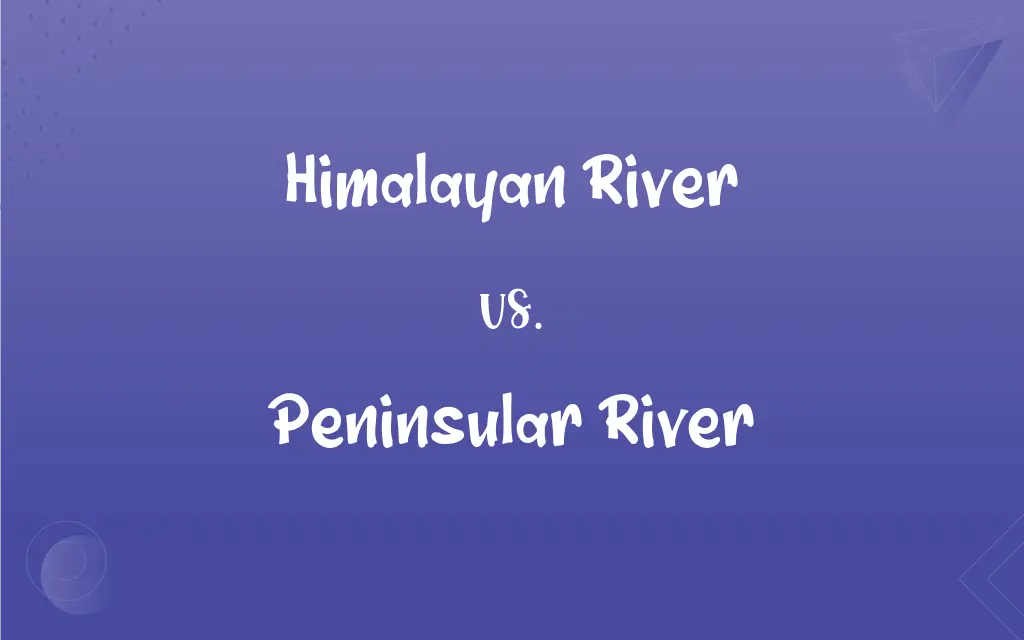Himalayan River vs. Peninsular River: What's the Difference?
Edited by Aimie Carlson || By Janet White || Published on February 13, 2024
Himalayan rivers are perennial, originating from the Himalayas, with large catchment areas and flow; Peninsular rivers, originating in the Indian Peninsula, are mostly rain-fed and have shorter, seasonally variable flow.

Key Differences
Himalayan rivers originate from the Himalayan range, ensuring a perennial flow due to glacial and monsoon contributions. In contrast, Peninsular rivers, emerging primarily in the Indian Peninsula, primarily rely on rainfall, leading to significant seasonal variations in their flow.
Rivers from the Himalayas have extensive catchment areas and are generally longer, covering vast geographical stretches. Peninsular rivers, however, have smaller catchment areas and are comparatively shorter.
Himalayan rivers carry a substantial amount of sediments from the mountains, contributing to fertile delta regions. Peninsular rivers carry lesser sediments due to their shorter course and limited erosion, resulting in smaller deltas or no delta formation.
The flow in Himalayan rivers is more reliable and less seasonal, making them suitable for year-round irrigation and hydroelectric power. Peninsular rivers exhibit a highly seasonal flow, largely depending on the monsoon, affecting their consistency for irrigation and power generation.
The Himalayan rivers have created deep gorges and valleys in their upper courses, contributing significantly to the region's ecology and landscape. Peninsular rivers, flowing through hard rock terrains, have a different impact on the landscape and ecology, often forming unique riverine features.
ADVERTISEMENT
Comparison Chart
Source
Himalayan glaciers and monsoons
Indian Peninsula, mostly rain-fed
Flow Characteristic
Perennial, less seasonal
Seasonal, heavily reliant on monsoons
Catchment Area and Length
Large catchment area, longer rivers
Smaller catchment, shorter rivers
Sediment Transport
High sediment load, forming large deltas
Lesser sediment, small/no deltas
Utility and Dependability
Reliable for irrigation and hydropower
Less consistent, varies seasonally
ADVERTISEMENT
Himalayan River and Peninsular River Definitions
Himalayan River
A river flowing through South Asia, originating in the Himalayan region.
The Yamuna, a Himalayan river, merges with the Ganges at the Triveni Sangam.
Peninsular River
A river that originates in the Indian Peninsula.
The Godavari, a peninsular river, is often referred to as the Dakshina Ganga or 'Ganges of the South'.
Himalayan River
A river known for its less seasonal, reliable flow.
The Kosi, a Himalayan river, is crucial for irrigation in its basin.
Peninsular River
A river with limited delta formation.
The Mahanadi, a peninsular river, forms a small delta at its mouth.
Himalayan River
A river carrying a high sediment load from the Himalayan mountains.
The Indus, a Himalayan river, forms a large delta before entering the Arabian Sea.
Peninsular River
A river with a smaller catchment area and lesser sediment load.
The Tungabhadra, a peninsular river, is a tributary of the larger Krishna River.
Himalayan River
A river originating from the Himalayas, often fed by glaciers.
The Ganges, a Himalayan river, is revered and heavily utilized in India.
Peninsular River
A river characterized by seasonal variability in flow.
The Narmada, a peninsular river, is revered and heavily dependent on seasonal rains.
Himalayan River
A perennial river system with significant catchment areas.
The Brahmaputra, a Himalayan river, sustains a rich biodiversity in its basin.
Peninsular River
A river primarily dependent on monsoon rains.
The Kaveri, a peninsular river, is central to agriculture in Tamil Nadu and Karnataka.
FAQs
What are Himalayan rivers known for?
Himalayan rivers are known for their perennial flow, large catchment areas, and significant sediment transport.
Are Peninsular rivers less reliable for irrigation?
Yes, due to their seasonal nature, Peninsular rivers can be less reliable for year-round irrigation.
What characterizes Peninsular rivers?
Peninsular rivers are characterized by their dependence on monsoon rains, shorter lengths, and seasonal flow.
How do Himalayan rivers contribute to delta formation?
They carry high sediment loads, contributing to the formation of large, fertile deltas.
Are Peninsular rivers prone to seasonal fluctuations?
Yes, their flow significantly fluctuates based on the monsoon season.
What is a key ecological benefit of Himalayan rivers?
They support diverse ecosystems and sustain vast fertile plains.
How do Peninsular rivers affect the Indian Peninsula's landscape?
They form unique riverine features, shaping the landscape of the Indian Peninsula.
Can Himalayan rivers be used for hydropower generation?
Yes, their consistent flow and large catchment areas make them suitable for hydropower.
Is navigation common in Peninsular rivers?
Navigation is limited in Peninsular rivers due to their seasonal flow and shallower depths.
Do Himalayan rivers have a significant impact on agriculture?
Yes, their perennial nature makes Himalayan rivers vital for irrigation and agriculture in their basins.
How do both river systems impact India's economy?
Both Himalayan and Peninsular rivers are crucial for agriculture, water supply, and hydroelectric power, significantly contributing to India's economy.
How do Himalayan and Peninsular rivers affect soil fertility?
Himalayan rivers enrich soil with sediments, while Peninsular rivers' impact is lesser due to limited sediment load.
What is the significance of Himalayan rivers in Indian mythology?
Many Himalayan rivers are considered sacred in Indian mythology and culture.
Do Peninsular rivers form large deltas?
Generally, Peninsular rivers form smaller deltas or no deltas due to their lower sediment transport.
Are Himalayan rivers important for transportation?
Yes, they serve as crucial inland waterways in some regions.
What is the role of Peninsular rivers in regional cultures?
Peninsular rivers hold significant cultural and religious importance in their respective regions.
Are Peninsular rivers affected by urbanization?
Yes, urbanization and industrialization impact the water quality and ecology of Peninsular rivers.
Do Peninsular rivers face challenges due to damming?
Yes, damming and water diversion projects on Peninsular rivers lead to environmental and social challenges.
How does climate change affect Himalayan rivers?
Climate change impacts glacial melt, affecting the flow and volume of Himalayan rivers.
Do Himalayan rivers support a variety of flora and fauna?
Yes, they support rich biodiversity, including various flora and fauna.
About Author
Written by
Janet WhiteJanet White has been an esteemed writer and blogger for Difference Wiki. Holding a Master's degree in Science and Medical Journalism from the prestigious Boston University, she has consistently demonstrated her expertise and passion for her field. When she's not immersed in her work, Janet relishes her time exercising, delving into a good book, and cherishing moments with friends and family.
Edited by
Aimie CarlsonAimie Carlson, holding a master's degree in English literature, is a fervent English language enthusiast. She lends her writing talents to Difference Wiki, a prominent website that specializes in comparisons, offering readers insightful analyses that both captivate and inform.































































